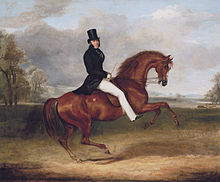George Stanhope, 6th Earl of Chesterfield
The Right Honourable The Earl of Chesterfield PC | |
|---|---|
 George Augustus Frederick, 6th Earl of Chesterfield, on his favourite hack by Sir Hercules | |
| Master of the Buckhounds | |
In office 30 December 1834 – 8 April 1835 | |
| Monarch | William IV |
| Prime Minister | The Viscount Melbourne |
| Preceded by | The Earl of Lichfield |
| Succeeded by | The Earl of Erroll |
| Personal details | |
| Born | 23 May 1805 |
| Died | 1 June 1866 (1866-07) (aged 61) |
| Nationality | British |
| Political party | Tory |
| Spouse(s) | Hon. Anne Elizabeth Weld-Forester (d. 1885) |
| Alma mater | Christ Church, Oxford |
George Stanhope, 6th Earl of Chesterfield, PC (23 May 1805 – 1 June 1866), styled Lord Stanhope until 1815, was a British Tory politician, courtier and race horse owner. He served as Master of the Buckhounds under Lord Melbourne from 1834 to 1835.
Contents
1 Background and education
2 Political career
3 Horse racing
4 Family
5 Styles of address
6 References
7 External links
Background and education
Chesterfield was the son of Philip Stanhope, 5th Earl of Chesterfield, and his wife Lady Henrietta, daughter of Thomas Thynne, 1st Marquess of Bath, and was educated at Eton and Christ Church, Oxford.
Political career
He succeeded his father in the earldom in 1815 at the age of ten and later took his seat on the Tory benches in the House of Lords. He served briefly in the Tory administration of Sir Robert Peel as Master of the Buckhounds from December 1834[1] to April 1835[2] and was sworn of the Privy Council in December 1834.[3]
Horse racing
Lord Chesterfield had a great passion for horse racing and spent most of his early years indulging in that pursuit. Although he had some success on the turf, winning the Oaks twice, his victories were not frequent enough to pay for the large string of horses he had in training or to finance his lifestyle of lavish party giving and gambling. His racing colours of red cap and jacket with blue sleeves were also carried to victory by Tom Olliver in the 1843 Grand National aboard his horse Vanguard.[4] In 1840, after the success of Crucifix he decided to give up his expensive mode of living and retire to Bretby Hall. He did construct a gallop of two miles to exercise his horses. Many eminent people visited Bretby to try out their horses or for shooting in Bretby Park. Among them were the Earl of Wilton, the Earl of Londesborough, Lord Newport and Sir Henry des Voeux. The best jockeys also came to Bretby.[citation needed]
Family

Two of the earl's horses in 1838; on the left Industry, who won the Oaks that year, on the right Caroline Elvina, who also ran in the Oaks but was unplaced. She was sold to the emperor of Russia (John Frederick Herring, Sr., 1838)[5]
Lord Chesterfield married the Honourable Anne Elizabeth Weld-Forester, daughter of Cecil Weld-Forester, 1st Baron Forester, in 1830. They had one son and one daughter. Their daughter Lady Evelyn Stanhope (1834–1875) was the first wife of Henry Herbert, 4th Earl of Carnarvon. Lord Chesterfield died in June 1866, aged 61, and was succeeded in the earldom by his only son, George. The Countess of Chesterfield died in July 1885, aged 82. Like her sister Selina, Countess of Bradford, she was an intimate friend of Benjamin Disraeli. After they had both been widowed Disraeli is said to have proposed to her, but she declined on the ground that people over seventy just look foolish when they decide to marry. Some of their friends thought that she refused him because she believed that he cared more for her sister Selina.[6]
Styles of address
- 1805–1815: Lord Stanhope
- 1815–1834: The Right Honourable The Earl of Chesterfield
- 1834–1866: The Right Honourable The Earl of Chesterfield PC
References
^ "No. 19225". The London Gazette. 30 December 1834. p. 2349..mw-parser-output cite.citation{font-style:inherit}.mw-parser-output .citation q{quotes:"""""""'""'"}.mw-parser-output .citation .cs1-lock-free a{background:url("//upload.wikimedia.org/wikipedia/commons/thumb/6/65/Lock-green.svg/9px-Lock-green.svg.png")no-repeat;background-position:right .1em center}.mw-parser-output .citation .cs1-lock-limited a,.mw-parser-output .citation .cs1-lock-registration a{background:url("//upload.wikimedia.org/wikipedia/commons/thumb/d/d6/Lock-gray-alt-2.svg/9px-Lock-gray-alt-2.svg.png")no-repeat;background-position:right .1em center}.mw-parser-output .citation .cs1-lock-subscription a{background:url("//upload.wikimedia.org/wikipedia/commons/thumb/a/aa/Lock-red-alt-2.svg/9px-Lock-red-alt-2.svg.png")no-repeat;background-position:right .1em center}.mw-parser-output .cs1-subscription,.mw-parser-output .cs1-registration{color:#555}.mw-parser-output .cs1-subscription span,.mw-parser-output .cs1-registration span{border-bottom:1px dotted;cursor:help}.mw-parser-output .cs1-ws-icon a{background:url("//upload.wikimedia.org/wikipedia/commons/thumb/4/4c/Wikisource-logo.svg/12px-Wikisource-logo.svg.png")no-repeat;background-position:right .1em center}.mw-parser-output code.cs1-code{color:inherit;background:inherit;border:inherit;padding:inherit}.mw-parser-output .cs1-hidden-error{display:none;font-size:100%}.mw-parser-output .cs1-visible-error{font-size:100%}.mw-parser-output .cs1-maint{display:none;color:#33aa33;margin-left:0.3em}.mw-parser-output .cs1-subscription,.mw-parser-output .cs1-registration,.mw-parser-output .cs1-format{font-size:95%}.mw-parser-output .cs1-kern-left,.mw-parser-output .cs1-kern-wl-left{padding-left:0.2em}.mw-parser-output .cs1-kern-right,.mw-parser-output .cs1-kern-wl-right{padding-right:0.2em}
^ "No. 19266". The London Gazette. 1 May 1835. p. 857.
^ "No. 19225". The London Gazette. 30 December 1834. p. 2348.
^ www.tbheritage.com The Grand National Archived 15 March 2009 at the Wayback Machine
^ Catalogue Note for the painting of Industry and Caroline Elvina by John Frederick Herring Sr.
^ Pearson, Hesketh Dizzy- the life and personality of Benjamin Disraeli, Earl of Beaconsfield Harper Collins New York 1951 p.243
External links
- Hansard 1803–2005: contributions in Parliament by the Earl of Chesterfield
| Political offices | ||
|---|---|---|
| Preceded by The Earl of Lichfield | Master of the Buckhounds 1834–1835 | Succeeded by The Earl of Erroll |
Peerage of England | ||
| Preceded by Philip Stanhope | Earl of Chesterfield 1815–1866 | Succeeded by George Philip Cecil Arthur Stanhope |